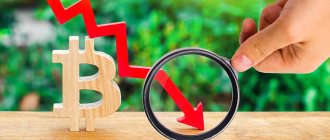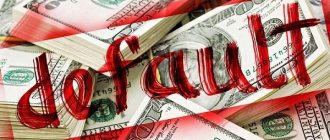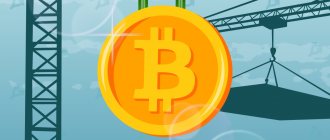Deflation is a general decrease in the prices of goods and services in the economy. It occurs when the inflation rate becomes negative. Deflation is different from disinflation, which is only a slowdown in the rate of inflation (and marks the speed of that change). Deflation causes the purchasing power of a currency to increase. In other words, you can have the same amount of money, but because prices are lower, your money will allow you to buy more goods.
Learn more about deflation, how it occurs, and how it can affect various market indicators.
Deflation, what is it?
Deflation is the reverse process of inflation. Lower prices should stimulate the ability to buy new products. In fact, this causes lower wages and greater unemployment. Enterprises go bankrupt because they receive less revenue, cannot cover production costs, or take out loans for development.
Most often, deflation is recorded at the end of a month or quarter. For example, when calculating the price index, an increase for the 1st and 2nd quarter is revealed - 0.3% and 0.5%. In the 3rd and 4th quarters, the price index will decrease by 1% and 1.4%, that is, inflation will occur. The final annual price index will be:
1+1.4-0.3-0.5 = 1.6% (inflation).
In some cases, deflationary processes appear when calculating the index based on the results of a year or several years.
Deflation and disinflation: what's the difference?
Deflation should not be confused with disinflation. Although both names sound like they indicate prices are falling, disinflation actually means prices are still rising, just slower than before. This could be a change from 4% annual inflation to 2% annual inflation, meaning that an item that used to cost $10 now sells for $10.02 instead of the projected $10.04.
On the other hand, deflation describes the actual decline in prices rather than a decrease in the rate of inflation. With 2% deflation, an item that used to cost $10 now costs $9.98.
Types of deflationary processes
There are four main types of deflation:
- Deflation of bank loans occurs when holders withdraw money from deposits en masse. The banking system is changing, unreliable banks are going bankrupt, and the market value of securities is falling. Debt deflation results in borrowers having to pay back loans with increased debt costs. This benefits creditors, but not debtors
- build-up deflation implies widespread accumulation of currency on hand. The economic situation is deteriorating, citizens stop spending because they do not trust the state
- Growth deflation occurs when demand for a specific product increases. The volume of production of a product increases, and its price falls. This process has both positive and negative impacts on the country’s economy.
- Confiscatory deflation occurs when government agencies seize funds from citizens and businesses. There are fairer methods of mitigating deflation than cash confiscation
The state can use a variety of monetary and tax mechanisms. For example, increase the key banking rate, limit cash flows, withdraw some cash from circulation, increase taxes, reduce the cost of maintaining the state apparatus. At the same time, control over the sphere of currency circulation, foreign trade, and the sale of government securities is being strengthened.
Anti-inflationary measures of the state
Considering the current unstable situation in the economy, there are signs of inequality in the balance of payments statistics of different countries in recent years. This means that the current account balance and the closing balance will not be equal to zero. Large fluctuations in the balance cause negative economic consequences for the country. For example, with a sharp increase in the positive balance, a rapid increase in the money supply occurs, which stimulates inflation.
When the balance is negative, the exchange rate falls, which negatively affects the country's external economy. Regulation of the deficit balance of payments occurs under the control of the state. Monetary regulation in a financial crisis must be carried out within certain boundaries and exclude contradictions. Several methods are used for this:
- Direct control.
- Deflation as a counteraction to inflation.
- Changes in currency exchange rates.
In difficult economic situations, in order to streamline the flow of funds and strengthen the monetary system, the state carries out monetary reforms, such as:
- devaluation - an official decrease in the value of a currency in relation to foreign currencies (freely convertible);
- denomination is a reform in which the monetary unit does not change, but the nominal value of the notes changes (a certain number of zeros are cut off). There is an exchange of obsolete money for new ones;
- revaluation - the exchange rate of the state currency is officially increased;
- Nullification is a variant of denomination, sometimes combined with devaluation, when old banknotes are exchanged for new ones at a very low rate.
The state's anti-inflationary policy should not only restore the economy as a whole, but also increase the standard of living and income of the population.
Reshaping the cash flow structure
Due to changes in cash flows, enterprises gain access to easy sources of financing:
- the most accessible stock and bond markets
- loosening of financial policy when interest rates fall
- investors' willingness to take serious risks
Thanks to the capital received, companies modernize, launch new production, and increase productivity. The total volume of products on the market is increasing. To increase competitiveness, businessmen reduce prices, which leads to deflation.
Deflationary phenomena cause an increase in the supply of money when the real incomes of ordinary citizens remain at the same level.
Consequences of deflation for the economy
Why can deflation be bad? Deflation is as dangerous for the state's economy as inflation. Deflation can be beneficial only if it is observed in a certain industry, and as a result of healthy competition. For example, a bakery reduces the cost of its products by 20%. Its competitors are forced to either reduce the cost of their products or offer customers something new at the best price.
The consequences of deflation for the economy are quite significant
. First, manufacturers must reduce the cost of goods or services to attract more buyers. The purchasing power of the population is not increasing because everyone is waiting for an even greater fall in prices.
Secondly, as a result of the reduction in the cost of their goods, manufacturers reduce the cost of their production. As a result, there is a reduction in staff.
The country's unemployment rate
. This has a negative impact on economic development. In addition, wages are falling. Which also leads to a decrease in the purchasing power of the population.
Dangerous deflationary spiral
A deflationary spiral is a protracted process of deflation. It can be observed for several years. During it, a growing unemployment rate, a constant decline in production and other processes are recorded. It becomes simply impossible to control them. Especially if the government pursues ineffective economic policies. The consequences of deflation have to be fought for several years.
Production growth
An economic crisis can cause rapid development of production:
- introduction of innovations and new technologies increases productivity
- inventions influence the development of individual industries or state economies
- high levels of productivity drive prices down
- international corporations are opening factories in third world countries
Developing countries have a lot of cheap labor. People are willing to work for meager pay. This allows you to reduce production costs and prices while increasing the volume of supplies. In the early 2000s, deflation hit the United States as American companies opened production facilities in developing countries.
Causes and consequences
Among the causes of deflation are:
- an economic crisis that makes it difficult to find a job;
- changes in the money supply that affect the general price level;
- excessive debt in connection with the repayment of loan obligations in the absence of money emission;
- inadequate monetary policy, consisting of maintaining interest rates that are too high and using restrictive instruments;
- bank deposits with high interest rates.
The consequences of deflation can be:
- monetary increase in value;
- redistribution of real funds from borrowers to lenders;
- reduction in aggregate demand, i.e. debt deflation;
- reduction in profitability of production and investment;
- economic stagnation and high domestic debt;
- limiting the influence of monetary policy on the economy;
- loans become very expensive and are not used to finance investments, which constrains economic growth;
- Budget expenditures increase as the number of unemployed people increases and, consequently, the number of benefits paid increases. Thus, the budget deficit and public debt increase;
- an increase in real household debt, causing a fall in consumer demand;
- the need to reduce employment caused by the desire to maintain the company's labor costs at a constant level.
Why is deflation so dangerous for the economy?
Despite a temporary increase in the purchasing power of the population, long-term deflation has a negative impact on the economy. A fall in prices while maintaining the same high production costs ceases to be profitable.
And consumers, hoping for even lower prices, are postponing purchases, which, in turn, leads to a growing recession. Deflation also causes loan prices to rise, which means that the development of companies using bank support also slows down and even stops.
Is there harmless deflation?
Deflation is considered harmless if it is accompanied by an increase in purchasing power simultaneously with economic growth, increased activity of business units in market conditions, increased competitiveness of enterprises and other positive factors in the economy. In such a situation, an increase in the well-being of the population is noticeable.
Regulation of money supply at the state level
The choice of measures to mitigate inflationary or deflationary processes depends on economic policy. Decisions made by the government can stimulate deflation:
- The central bank changes rates, thereby reducing the supply of currency or the volume of loans issued, which causes another fall in prices
- in order to fight inflation, the state withdraws part of the money from circulation, which causes a drop in the cost of goods (the situation is typical for developed countries, but not for Russia)
- the government reduces budget expenditures by introducing a strict austerity program (2010 in Spain)
- increase in taxes, artificial “slowdown” of wage growth
Kinds
Main types of deflation:
- Growth deflation. The reason for this is an excess supply in the market, a decrease in prices for products from the manufacturer due to competition.
- Increasing cash balances: hoarding. A situation in which cash is specifically kept in the buyer’s wallet, and other forms of payment are used.
- Bank credit deflation is characterized by a decrease in the supply of money due to bank failures.
- Confiscation: associated with a violation of property rights, the seizure of cash from the population by force by the state.
Inflation and deflation
Inflation (from Latin “inflation”) is a process of rising prices over time, present in the economies of many countries. Deflation (“deflation”) is the opposite mechanism. Economists identify a number of factors causing inflation:
- an increase in demand for goods and services causes market shortages and, as a result, price increases
- rising production costs stimulate a reduction in output volumes and lead to shortages of goods (cost-cost inflation)
- monopolization of certain sectors of the economy
- artificial inhibition of prices spurs inflation (for example, the 1990s in Russian history, when there was a transition from a planned system with price controls to a market economy)
Deflation is the cause of insufficient demand, which can be more destructive than inflationary processes. A serious economic crisis is caused by 1-2% deflation per year. It is characterized by a fall in all price economic indicators, including wages.
What role did deflation play in history: examples
Let's look at examples of the role deflation played in different countries.
The Great Depression
Deflation precipitated one of the worst economic periods in the United States, the Great Depression. Although it began as a recession in 1929, the rapidly declining demand for goods and services caused prices to fall significantly, causing many companies to fail and unemployment to rise. Between the summer of 1929 and early 1933, the wholesale price index fell by 33% and the unemployment rate exceeded 20%.
Price deflation due to the Great Depression occurred in virtually every industrialized country in the world. In the United States, output did not return to its previous long-term trend until 1942.
Deflation in Japan
Since the mid-1990s, Japan has been experiencing a state of moderate deflation. In fact, Japan's consumer price index has almost always been slightly negative since 1998, except for a short period before the global financial crisis of 2007–2008. Some experts attribute the problem to Japan's output gap—the difference between actual and potential output in the Japanese economy. Others believe the problem lies in insufficient monetary easing.
In any case, the Bank of Japan is currently pursuing a negative interest rate policy, a monetary policy that slightly penalizes people for holding money, and forecasts that the CPI will fall to at least negative 50 basis points through March 2022.
Great Recession
During the US recession from late 2007 to mid-2009, there were many concerns about deflation. Commodity prices fell, making it harder for debtors to repay their loans. The stock market fell, unemployment rose, and home prices plummeted.
Economists were concerned that deflation would lead to a deep downward economic spiral, but this did not happen. One study published in the American Economic Journal suggests that the early financial crisis managed to prop up inflation. Because interest rates were so high at the start of the recession, some companies could not afford to cut prices, which may have helped the economy avoid widespread deflation.
Inflation and its role in the modern economy
Since the 1970s, inflation has stimulated the development of the economies of many countries around the world and is an inevitable process. The impact is determined by the growth rate:
- 1-3% per year is low inflation, harmless and spurring stable economic growth (EU countries, USA with a level of no more than 2%)
- 6-14% – inflationary fluctuations in Russia in recent years
- 20-30% – high inflation, causing a number of problems, including unpredictable interest rate fluctuations, slowdown in GDP growth, weakening investor activity
- 1000% – hyperinflation, which is accompanied by the collapse of the system and economic crisis
Why deflation is more harmful than inflation
When prices rise and the value of a currency falls, the economy experiences inflation. While inflation means your ruble doesn't stretch as much, it also reduces the value of debt so borrowers keep borrowing and debtors keep paying their bills. Moderate inflation is normal in the business cycle: the economy typically experiences inflation of 1% to 3% per year, and low inflation is generally seen as a sign of healthy economic growth.
Inflation is also something that consumers can protect themselves from to a certain extent. For example, investing money can help your income grow faster than inflation, helping you maintain and increase your purchasing power.
While it may seem that rising prices are worse than falling prices, deflation is generally less favorable and is associated with economic downturns and recessions. A deflationary spiral can turn tough economic times into a recession and then into a depression.
Deflation is also a little more difficult to protect against than inflation. Unlike inflation, deflation makes debt more expensive, causing people and businesses to avoid taking it out as they try to pay off the increasingly costly debts they already have.
During periods of deflation, the best place for people to keep money is usually in cash investments that don't generate much or no return. Other types of investments, such as stocks, corporate bonds and real estate, are riskier in a deflationary environment, as businesses could face very difficult times or go out of business completely.
Price deflation
Deflation occurs when the price index falls below 0%. Lower prices cause more serious harm to society than inflation. This leads to a decrease in investment, unemployment, and an aggravation of the credit problem. In this situation, financial and monetary risks increase.
The depression in the United States in 1929–1933 was more severe than in Europe, as the price level dropped significantly. During deflationary processes, consumer demand weakens. Buyers expect an even greater reduction in prices and plan to purchase apartments, houses, cars and other expensive purchases in the future. The situation is hurting the economy and triggering a spiral.
Deflation: examples from history
Throughout the post-Soviet history of its existence, Russia has been tormented by inflationary risks, so for us deflation is rather a theoretical concept. But in order not to be unfounded, we will give two of the most famous examples from the life of other countries that had to feel the consequences of deflation.
"Great Depression" in the USA
The first signs of the economic crisis in North America appeared long before 1929, when it broke out in full force. Economic growth (from 1913 to 1927, US national income almost tripled) was accompanied by rapid growth in the speculative sector. Every fourth American participated in stock market games. The money supply was growing (it increased by 60% the year before the crash); the country experienced a boom in credit purchases at low rates.
At the same time, already from the end of 1925, the pace of construction and production of machines slowed down: due to the flow of funds into the consumer and financial sectors, there began to be a shortage of money supply for investment in fixed assets.
As the economy slowed, the Federal Reserve tried to galvanize it by lowering the refinancing rate. This further stimulated lending, but the money supply went to the stock exchange and became increasingly unsecured. This had a negative impact on the prospects of the economy, since the dollar exchange rate was strictly tied to the price of gold, and it was impossible to simply print money.
In 1928, the Fed tried to reduce the injection of “empty” money into the economy as much as possible in order to prevent further inflating of the stock market bubble. The interest rate on the loan increased, protectionist measures led to an increase in local production, which was not met by demand. Inflation dropped sharply almost immediately, and the shortage of national currency for financial transactions began to be felt more and more.
The demand for company shares fell (there was simply nothing to buy them for), and after them, prices for real products traded on the stock exchange began to sharply decline. On October 29, 1929, “Black Tuesday” happened: brokers put more than 16 million shares on sale - by the end of the day they were selling for next to nothing. The country's market capitalization fell by 15%.
Over the next week, deflation swept through all sectors of the economy. Prices for basic goods that formed the skeleton of the US economy at that time fell tenfold: wheat, cotton, fuel. Over three weeks, the loss amounted to about 30% of the country's GDP.
Depositors tried en masse to withdraw their deposits. As a result, banks, which had lost a significant part of their liquidity, stopped lending to clients. This led to the bankruptcy of hundreds of businesses. By 1932, about 10% of the US population was unemployed. A sharp decline in household and business incomes led to an avalanche-like reduction in demand and money supply in the country.
The government tried to stop the crisis by cutting taxes and increasing government spending. The latter method brought results - however, only a few years later, when Franklin Roosevelt became president, implementing his famous “New Deal”. The dollar was devalued and it ceased to depend on the price of gold.
Banks received significant government funds (in particular, government bonds were purchased, the only remaining liquid securities). The specially created National Administration for Industrial Recovery took control of the main markets: it was in charge of distributing quotas for the production of certain types of products (to avoid overproduction), setting prices for socially significant goods, determining credit conditions mandatory for all banks, and so on. .
By 1937, the crisis had subsided, deflation approached its minimum level, gradually turning into inflation.
Japan's "Lost Decade": 1990s
The Japanese economic miracle, which so surprised the world in the second half of the 20th century, also had its unexpected consequences. When the level of income of the population increased significantly, and the demand for basic necessities was generally satisfied, the Japanese Central Bank began to implement a policy of stimulating savings. As a result, along with bank deposits, the securities market began to grow sharply: free funds of the population and businesses went there. The increase in the profitability of the stock market led to the flow of not only free funds into speculative instruments, but also money intended for investment projects: it became more profitable for companies to make profits through financial transactions rather than through the real sector.
The real estate and construction sectors, as well as the stock market itself, traditionally “inflated” faster than others. The growth of construction lending at low rates led to a sharp increase in real estate prices, and industrial indices began to slow down significantly.
The Japanese government tried to limit the speculative market by increasing the key rate. However, this only led to the fact that, having reached their peak in 1989, the real estate and construction markets went down, eating up investments in these sectors and “squeezing” the money supply in the country. By 1993, prices in these areas had tripled, and investors lost billions of yen. This significantly slowed down already sluggish consumer behavior, resulting in a prolonged decline in other industries.
Deflation continued until 2004. Then there was a small surge associated with the introduction of inflation targeting (the Central Bank of Japan began to strictly regulate the interest rate, slightly reviving the economy), but after the global economic crisis of 2009, the country again fell into a period of deflation, which continues with short breaks to this day. This significantly slows down economic growth (since 2011, it has never exceeded one and a half percent).
Ways to mitigate deflation
Deflationary processes can be prevented and eliminated using the following measures:
- reduction of taxes for large, medium-sized businesses and individual entrepreneurs, establishment of tax discounts for investors investing in the country's economy
- investment of public funds in infrastructure development, construction of large facilities, creation of roads (the measure requires capital investment from business)
- increasing trust in government
- creating conditions to stimulate lending (lowering rates, extending credit periods, easing requirements for clients)
Central banks influence inflation and deflation rates by controlling the overall money supply. In the fight against deflation, only a moderate increase in the financial mass works.
The measures used by banks are not always effective, for example, reducing rates to zero, as was the case in 2008. As a result, the number of unemployed people increased and the volume of loans issued decreased. To date, clear methods for mitigating deflation have not been developed.
Factors of occurrence
Deflation differs from other processes in the economy in that it cannot occur within a short period of time. This is a long process caused by many factors. Important conditions for its development are:
| Factor | Peculiarity |
| Increased demand for cash and non-cash funds | The population begins to spend less money and save more, storing accumulated funds at home or in banks. Funds go out of circulation, therefore, the value of the national currency increases |
| Increased production volume | Enterprises produce more and more products, but household incomes remain unchanged |
| Regulation of the money supply by government measures | The state, due to the fight against inflation, is reducing the volume of money in circulation. Such deflationary policies sometimes produce the opposite result. To measure and calculate the money supply in the economy, monetary aggregates (types of money grouped by degree of liquidity) are used. |
| Reducing the volume of lending to the population | A reduction in the volume of loans issued to the population leads to a situation of a decrease in the amount of money in circulation and the risk of deflation |
Consequences of deflation
Deflationary phenomena are characteristic of an economy that is in decline or has reached a deep bottom. There are several negative consequences.
| 1. Decrease in company income | To maintain competitiveness, enterprises reduce product prices. Revenue volume decreases. Businesses may have time to return to their previous level of income if deflation stops. But in reality, deflationary cycles are repeated many times. During such periods, companies are forced to lower prices and reduce raw material costs. A drop in profits is inevitable; it cannot be increased even with increased productivity. |
| 2. Reducing salaries and layoffs | When revenues fall, enterprises begin to cut wages and fire staff. This causes another round of deflation as people start buying even less. |
| 3. Changes in consumer spending |
|
| 4. Reducing investment | During deflation, investors abandon other assets in favor of cash as their value rises. Deposits are becoming less profitable as banks reduce interest rates to reduce deflationary processes.
|
| 5. Lending reduction | When deflation occurs, lenders refuse to issue loans because:
In a deep crisis, even lowering rates cannot encourage consumers to take out loans. |
Deflation is like an economic winter, the effects of which last for many years. Companies are going bankrupt and the unemployment rate is rising rapidly. After a deflationary crisis, a state-owned economy may not recover, such as Hong Kong after the 2002 Asian crisis.
Deflation control
Governments have several strategies to curb deflation.
- Increase in money supply . With more supply, each ruble becomes less valuable, which encourages people to spend money and raises prices.
- More affordable loans . The central bank could ask banks to increase the amount of credit available or lower interest rates so people can borrow more. If the central bank lowers the reserve ratio, which is the amount of cash that commercial banks must hold on hand, banks can lend out more money. This stimulates spending and helps raise prices.
- Fiscal Policy Management . If the government increases government spending and cuts taxes, this could increase both aggregate demand and disposable income, leading to more spending and higher prices.
Deflation level
Inflation and deflation rates are measured using consumer price indices. Relative, percentage indicators are calculated based on data for a month, quarter, year.
The coefficients are called deflators. They allow you to fix the real price of a product and clear it of the inflationary component. The coefficient is used to calculate the price and cost of a product produced several years ago. Statistical reports from the Ministry of Economic Development are used as a source of information.
The main indices used in developing plans and forecasts include:
- consumer price index (the indicator reflects changes in the cost of food, non-food products, housing and communal services and gasoline)
- producer price index, which allows you to obtain information on price changes by industry, taking into account export prices (calculated for retail and wholesale trade, agriculture, energy, construction)
- indices of changes in salaries and incomes of citizens
How to beat deflation
There are several ways to reduce the negative consequences of deflation and reverse the process.
1Reducing the tax burden.
Reducing the tax burden usually revives the investment activity of an enterprise and gives it a certain margin of safety even in a crisis of overproduction.
2 Stimulating lending.
If the state or the banks themselves take steps towards lowering the interest rate on loans for end consumers, reducing requirements for borrowers and improving loan conditions, then the economy receives a serious influx of “real” money and an increase in demand for certain groups of goods, which can become drivers, leading the country out of stagnation.
3Stimulating infrastructure development.
This is usually done by the state. If the economy is stagnant, large infrastructure projects are launched to build roads, bridges, gas pipelines, and so on. The construction of these objects requires a large amount of building materials, and accordingly, the sphere of their production comes to life. The growing incomes of workers at the enterprises involved increase the demand for goods, and other market segments are also becoming more active.
4Tax preferences for large investors.
If the state is ready to provide benefits to large companies in exchange for participation in infrastructure and large investment projects, the process of overcoming the consequences of deflation will go even faster.
Deflation rate
The deflator coefficient reflects changes in economic indicators recalculated to current prices. Deflators are used to calculate GDP and GNP. Indices allow you to assess the scale of inflation and deflation. The deflator coefficient has a number of basic properties:
- is a collection of several indices
- fully assesses the scale of inflation
- converts GDP into comparable prices
Inflation and deflation make it difficult to determine the gross national product, so real and nominal indicators are calculated. In economics, the main types of indicators are used:
- foreign trade turnover coefficient is the average price index of exports and imports
- wholesale and consumer price indices
- deflators of total capital investment
- GNP deflator index, reflecting the cost of products, services and investment products excluding imported goods
- GDP deflator index, shows changes in the volumes of goods and services produced, used to calculate the cost of production volumes
Compared to a price index, deflators take into account a mix of goods and services along with new arrivals. The disadvantage of deflator coefficients is that they result in underestimated inflation forecasts.
Specialists from the Ministry of Economic Development calculate deflators for several years in advance. This allows you to think through measures to mitigate the consequences of negative economic processes. Based on the calculations, several scenarios for the country's development are created.
Many experts predict an inevitable rise in inflation in Russia. The state budget deficit does not allow businesses to activate the market. In the future, inflationary surges are possible due to fluctuations in oil prices. The Russian economy will not stabilize in the next few years. The authorities have not eliminated negative factors, such as rising prices, depreciation of the ruble, and falling oil prices.
Deflation in Russia and the world economy
In Russia
in 2022, a deflation level of 0.1% was recorded in August-September. Analysts attribute this to the fact that agricultural products ripen during this period. Therefore, prices for it are reduced. As a result, the demand for it decreases, and the supply increases. This was not dangerous for the economy, since with deflation there was a stable level of inflation. That is, deflation was observed in a certain spectrum of the economy. At the same time, the state controlled inflation, which remained at the same level for a long time (losses in one area were covered by income from another).
Japan faced deflation
,
USA
,
Latvia
,
Singapore
,
Greece
. Signs of this process are still being recorded. Japan has experienced deflation since 1990. It fluctuates at the level of 1-2%. At the same time, other economic indicators remain at a high level. For example, the standard of living of the population, the development of science and the unemployment rate.
USA, despite the fact that the budgets of the European Union
, has not been able to overcome deflation for many years.
And even reducing the discount rate to negative values does not help in this case. The fact is that the United States
is constantly pouring significant amounts into the economy. Production levels may decline due to numerous sanctions on foreign producers. The result is an increase in unemployment and a decline in production.
Counting example
Based on the example, the scheme for calculating the GDP deflator index will become clear. The data is conditional and is provided for illustrative purposes only:
| Name of product | Produced in 2022, in tons | Produced in 2022 | Price in 2022, per ton | Price in 2022 per ton |
| Wheat | 275 685 | 312 815 | 11 000 | 11 500 |
| Potato | 658 257 | 526 651 | 42 000 | 43 100 |
| Carrot | 451 157 | 509 821 | 57 000 | 59 000 |
| Cabbage | 278 875 | 378 782 | 78 000 | 80 000 |
The indicators for 2022 are taken as a basis. The calculation takes the form:
312,815*11,500 + 526,651*43,100 + 509,824*59,000 + 378,782*80,000 = 3,597,372,500 + 22,698,658,100 + 30,079,616,000 + 30,302,560 0 00 = 86,678,206,600 is GDPnominal
312,815*11,000 + 526,651*42,000 + 509,824*57,000 + 378,782*78,000 = 3,440,965,000 + 22,119,342,000 + 29,059,968,000 + 29,544,996 0 00 = 113,710,267,000 - result base period.
113,710,267,000 / 86,678,206,600 * 100% = 131.19% - the size of the GDP deflator.
Based on the GDP deflator, economists in each country calculate the level of well-being of the population and the real position of the state, as well as other economic indicators.
Deflation for consumers and producers
Let's look at the pros and cons of the deflation process for consumers and producers. With this phenomenon, an ordinary citizen receives very good benefits. For example, an ordinary employee of an enterprise received a salary of 1,000 rubles in January, which allowed him to purchase 4 bags of potatoes. But in February, the same salary allowed him to buy not only potatoes, but also a bag of cabbage.
That is, if wages do not decrease, the population is in the black and can even begin to save money. For the consumer, deflation processes become an opportunity to improve their own financial situation, if this happens without increasing taxation and reducing wages.
But for producers, the deflation index has exactly the opposite effect. The following situation arises - for example, a businessman took a loan of 1000 rubles from a credit institution to develop his business. He begins to grow onions, and in January the cost of one kilogram was 5 rubles. When the currency went up in February, the cost of onions dropped to 4 rubles per 1 kg.
If we consider the volume of revenue, it will certainly tend to decrease, but loan obligations will rise in price. The loan will be repaid in the same amount, but its price may vary significantly over the years or months.
Thus, deflation is a crisis, at least for businesses. Modern society presupposes market relations, so this situation affects the entire financial system of the country, which poses an even greater danger than inflation.
How deflation affected world states
The process of increasing the cost of money is not new; it has accompanied the development of the world economy for many decades. Deflation can be seen at various points in the development of the economy of a number of countries, if you start studying this issue.
During the Great Depression, when the New York Stock Exchange crashed in 1929, many financial institutions went bankrupt and customers lost all their deposits. This circumstance caused an impressive rise in the price of the currency, due to the artificial creation of a “credit bubble” and its inevitable explosion.
Another significant situation occurred in Japan, where in the late 1980s the government artificially increased the demand for real estate, which caused a significant increase in prices. Thus, the land under the imperial palace was worth approximately the same as the entire territory of the American state of California. It was impossible to maintain price increases for a long time, the bubble burst, after which there were numerous cases of bankruptcy of credit institutions and a drop in loan capital. Then the Japanese authorities again tried to carry out this procedure, but credit institutions and industry no longer wanted to participate in the scam. As a result, modern Japan has an extremely low demand for real estate and land, despite the small scale of unoccupied territories, whose value is declining every year.
To summarize, we can note a rather difficult definition of the concept of deflation, which is not so easy to explain in simple words. Obviously, this is a process of increasing the price of a currency, created artificially (by removing a certain amount of money from circulation) or naturally, by increasing the volume of production of goods and services.
In each situation, currency deflation has a strong impact on both production and the population, affecting the budgets of both ordinary citizens and entire countries. In Russia, this process happens extremely rarely, but some world states have already felt the full consequences of deflation.
How to calculate inflation
Inflation in Russia is measured by Rosstat: every month the agency publishes statistics based on the cost of the consumer basket. The consumer basket includes more than 550 products and services: from eggs and buckwheat to medicines, clothing, travel costs and hotel stays. Depending on whether the value of this basket has increased or decreased, one can draw conclusions about an increase or decrease in inflation.
At the same time, you need to understand that official inflation in the country may differ significantly from the individual inflation for a particular citizen. The point is the difference in consumer baskets. For example, yours may include more expenses for entertainment, travel and education than for food, which is not included in the same amount in the Rosstat basket.
Inflation may also differ depending on the region: in Krasnodar, fruit prices will be lower than in Magadan, which means the cost of the overall basket will decrease.
To calculate individual inflation, you need to make a list of standard purchases for your family: groceries, clothing, housing and communal services, services. Next, buy and pay for everything on this list at the beginning of the month and save the receipts. Repeat the same thing next month. This way you can compare the changed prices of your family’s consumer basket and determine your individual inflation rate.
Ways to fight
There are the following methods:
- the issue of money, which revives demand, equalizing its shortage in the market;
- a reduction in interest rates, making investments in the real economy more profitable than hoarding money;
- negative interest on time deposits as a commission for “parking” money;
- public works reduce unemployment, leading to the restoration of demand by paying wages to workers (the concept of J. M. Keynes);
- negative income tax - financing of the poor (concept of M. Friedman);
- introduction of tax incentives for investments;
- introduction of taxes on savings deposits.











